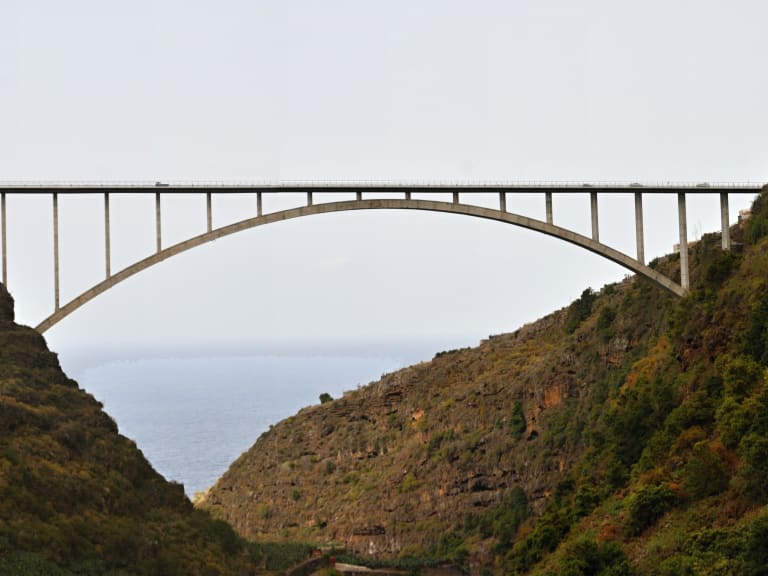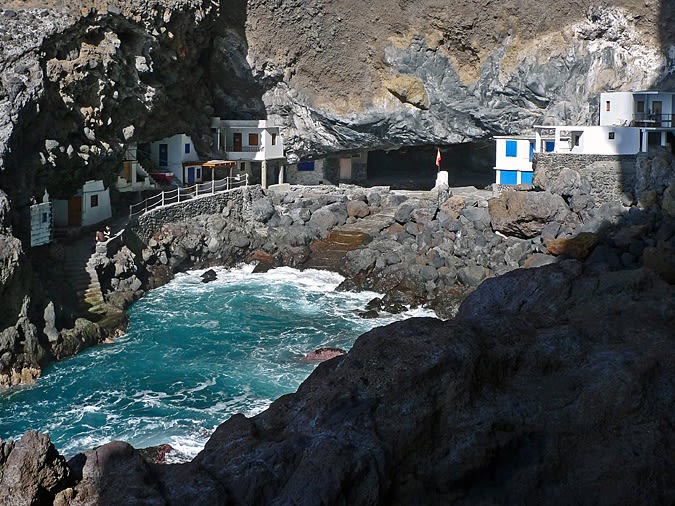La Palma in 5 Days: everything you need to know
Getting to know La Palma in 5 days is more than feasible. The only thing you have to do is to organise your trip well, so as not to leave behind any of the main tourist attractions on the Isla Bonita.

Santa Cruz de la Palma | ©Mardeviajes
Within the different islands that make up the Canary Islands, La Palma is not the most popular. It is usually more common to visit Tenerife or Gran Canaria. However, the Isla Bonita is so called for a reason. It is a paradise for hiking enthusiasts. During your trip, you can enjoy starry nights, trails through dreamlike forests, visits to charming villages on the shores of the Atlantic and impressive volcanoes. In short, there are many things to see and do in La Palma.
If you are planning a trip to La Palma in 5 days, take a look at this list of plans and activities that I recommend. As a preview: you'll need to pack some good hiking shoes and your camera to immortalise the beautiful landscapes you'll see during your visit to the Isla Bonita.
Day 1: Santa Cruz de la Palma and Nogales Beach

Santa Cruz de La Palma is the capital of the Isla Bonita and the first stop on this trip to La Palma in 5 days. I invite you to explore the old town, a perfectly feasible route to do on foot.
The beach of Nogales is an unspoilt beach located in the village of Puntallana. With volcanic sand and beautiful views of the mountains, it is one of the best beaches on La Palma. It will take you less than half an hour by car to get to Nogales beach from the capital.
Get to know Santa Cruz de La Palma
There are several must-see places and monuments in Santa Cruz de La Palma. The first of these is the Castle of Santa Catalina, which dates back to the 17th century and was built to defend the city from pirates.
Of course, you can't miss the Calle Real, which is the city's main avenue. Here you will find certain monuments of tourist interest, such as the monument to the Dwarfs of La Palma, the Barco de la Virgen museum, the Town Hall or the Matriz de El Salvador church.
Speaking of churches, a visit to the church of El Salvador is also a must. Finally, you can also visit some of the viewpoints, such as La Concepción or Barranco de Los Gomeros.
Savour the sea at Nogales beach
Nogales beach is not usually very busy, so it offers peace, quiet and relaxation. However, it is advisable to be careful with the tide, which tends to be very strong in this area.
To get to Nogales beach, take the LP-102. There is a car park where you can leave your car. From here, you will walk a 15-minute walk that is remarkable for its views.
In addition to a wonderful day at the beach, you can also take advantage of your visit to Nogales beach to do other activities. For example, very close to this place is the Cubo de Galga forest, where there are two routes: one that is over 10 kilometres long and another that is only 2 kilometres long.
If you prefer to indulge yourself before opting for hiking, I recommend that you try the authentic Canarian gastronomy at the Casa Asterio restaurant. Its specialities include ribs, fried cheese and, of course, papas arrugás with mojo picón.
Day 2: Teneguía and San Antonio volcanoes

The Teneguía Volcano is the penultimate volcanic eruption on the island. The eruption of this volcano in 1971 had a great impact on the southern tip of the beautiful island. Today, it is one of La Palma' s main tourist attractions.
Visit the Teneguía crater
This volcano is very close to that of San Antonio. In fact, in the visitor centre of the latter, you will learn part of the history of Teneguía. The path to the volcano passes through lava fields as a backdrop. You can choose to climb to the summit, although the reality is that it is a demanding route.
The effort is particularly high in summer, given the heat. However, there is no need to go all the way to the top, as the trail is worth the effort in itself. On this trail, you will discover the Roque de Teneguía, an archaeological site 400 metres high. The rock engravings in the area and the strange flora that decorates it are particularly interesting.
Discover the San Antonio volcano
To visit the San Antonio volcano from Teneguía, you can take a hiking route or opt to make the journey by car, which takes less than 15 minutes. When visiting the San Antonio volcano, the first stop on the route is the visitor centre.
Here you can get information about the different volcanoes on the beautiful island, as well as all the processes related to them. When you leave the visitor centre, there is a short walk to the top of the San Antonio volcano.
Once you have seen the crater of the volcano, I recommend that you continue along the path to appreciate the views of the coast and the sea. Also, from the Teneguía Volcanoes Natural Monument viewpoint, you will be able to see the youngest formation on the island, which is the result of the eruption that took place in 2021.
Day 3: Los Tilos, Charco Azul and San Andrés

The third day of your trip to La Palma in 5 days consists of getting lost in nature. You will start the day admiring the waterfall of Los Tilos. Afterwards, I suggest you head to Charco Azul, a natural swimming pool just 15 minutes away. Once you've enjoyed the surroundings, visit the village of San Andrés, which is about 5 minutes away by car.
Lose yourself in Los Tilos
Los Tilos waterfall is 60 metres high and is located in a laurel forest, the Los Tilos text forest. Right next to the waterfall, there is a visitor centre where you can enjoy typical Canarian food. The waterfall is usually very crowded, but it is still worth seeing.
To get there, you can complete the route by following the Marcos y Cordero trail. You can take a taxi to the starting point of the route. Afterwards, all you have to do is walk along a beautiful flat path where water is the main protagonist. The trail is just over 12 kilometres long and has several tunnels, so you should bring torches.
Bathe in the Charco Azul
I now move to the north of La Palma, an area of the island where you will find a natural pool called Charco Azul. On hot days, it is the perfect place to cool off and relax.
To get to Charco Azul, you will have to walk. There are different markings marking the way, so it is difficult to get lost.
In total, including the return journey, it is about 4 kilometres, so it is a very easy distance to cover. At the end of the walk, you can go to the beach of El Risco.
Explore San Andrés
Very close to Charco Azul is the village of San Andrés. To reach this municipality, you will cross the largest single-arch bridge in the country. The highlight of San Andrés is the church of San Andrés Apóstol, which has been declared an Asset of Cultural Interest. This church is located in the main square of the town, which is the nerve centre.
With the sea as a showcase, San Andrés is a beautiful town with large houses, which are proof of the great importance that the municipality has had during its history in the region.
Day 4: National Park of La Caldera de Taburiente, Roque de los Muchachos

The Roque de los Muchachos is the second highest point in the Canary Islands, with an altitude of 2,426 metres. It is located in the Caldera de Taburiente National Park and offers a wide range of activities to do.
Take a route through La Caldera de Taburiente National Park
The Canary Islands boast an impressive wealth of scenery and natural beauty. One of its greatest relics is La Caldera de Taburiente National Park.
To reach this magical place, you can do so from the Cumbrecita viewpoint or from the Brecitos viewpoint. The former is of low difficulty. On the other hand, the second starting point is only recommended for expert walkers.
Among the points of interest in the park is the La Caldera de Taburiente Visitor Centre. This is a museum where, through various exhibitions, you will discover all the curiosities of the park: from its fauna to its history. I also recommend the Roque de los Muchachos viewpoint, which is the highest peak on the island.
Take in the views from Roque de los Muchachos
The first thing you should do is go to the Roque de los Muchachos viewpoint. If the sky is clear, you will enjoy breathtaking views of nature. What's more, it will only take you a few minutes on foot to get there.
If you like astronomy, I recommend that you take advantage of the walk to go to the Roque de los Muchachos Astronomical Observatory, one of the best in the world.
Here you can see the different telescopes it houses, as well as the discoveries attributed to it. Night-time stargazing excursions are also organised on the Roque de los Muchachos, specifically on the esplanade of the LP-4 road. There are several routes that can be taken on the Roque de los Muchachos. One of the easiest is the one to the Espigón del Roque, which takes about half an hour.
Day 5: Porís de la Candelaria, Tazacorte and Puerto Naos

Porís de la Candelaria is a municipality that is sure to surprise you. It is made up of a group of cave houses located by the sea. Tazacorte is another charming coastal town, which is about 40 minutes away by car. Finally, round off the day with a visit to Puerto Naos, less than half an hour away.
Be amazed by the cave houses of Porís de la Candelaria
It is located on the coast of Tijarafe and is the best example of man's ability to adapt to the different irregularities of nature.
I recommend that you visit the beach of La Veta, although it is not easy to get to. Bear this in mind if you are travelling with children, and don't forget to bring suitable footwear and some water. In addition to this beach, Porís de la Candelaria is also home to the Time viewpoint, which offers unbeatable views of Llanos de Aridane, Naos, Tazacorte and Fuencaliente.
Enjoy a day at the beach in Tazacorte
Tazacorte is of great tourist interest for its beautiful beach of volcanic sand and its marina. It is in the harbour of this town that the boats for whale watching leave from.
Of the town's two beaches, the most famous is that of Puerto de Tazacorte, which is located next to the pier. It is a very safe beach for children, due to the calmness of the water.
The other beach in Tazacorte is Los Guirres, which is larger than the previous one. It is usually a little emptier than the beach of Puerto de Tazacorte, which makes it ideal for those looking for peace and quiet. It is also perfect for surfers, thanks to its waves.
Enjoy a sunset in Puerto Naos
Puerto Naos is a coastal town belonging to Los Llanos de Aridane. It was once a fishing and banana-growing village. The most striking feature of Puerto Naos is its marvellous beach of black volcanic sand.
Here you will find all kinds of services, such as deck chairs, public toilets and beach bars where you can taste the island's fresh fish. It is here that you can see one of the most beautiful sunsets on La Palma. Therefore, if you don't have time to spend the whole day on the beach, I advise you to at least arrive in time to see the sunset.
Apart from the beach of Puerto Naos, the centre of the town is also very nice to see. Among the most striking places is the Plaza de La Glorieta, designed by Luis Morera. Of course, you can't miss the Todoque volcanic tube, formed by the eruption of the San Juan volcano.
As you can see, a 5-day trip to La Palma can be very complete. In fact, you can also get to know the Isla Bonita in depth with only 4 days of travel. My recommendation is that you look at the best excursions and tours on La Palma and that you take into account your physical abilities when choosing one or the other. It is also important that you are well equipped with quality shoes.
